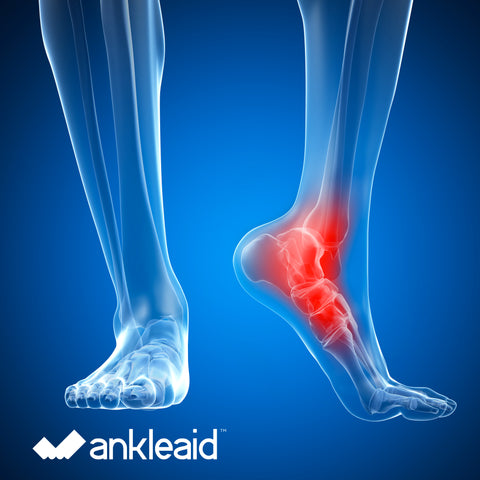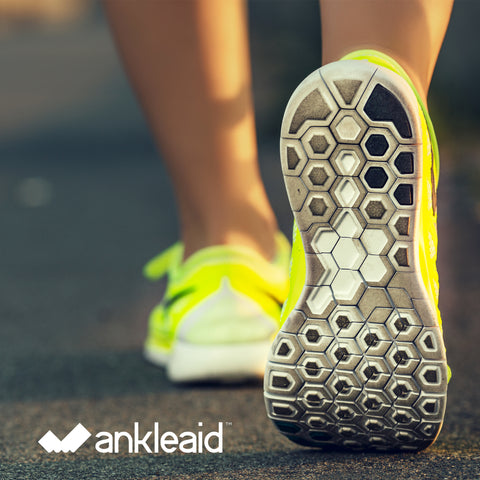
Tissue treated in cold-water immersion remains cooler significantly longer which translated means a better therapeutic treatment. However, patients tend to have an aversion to full foot immersion because of the cold discomfort to the toes (personal clinical experiences). The most common method of reducing the toes discomfort is to apply a ‘toe cover’, which reduces the amount of cold water reaching the toes, but many patients still prefer ice bags. The AnkleAid is a single foot cold-water immersion device, which features a preformed area for placing the injured foot, which ensures a 360 degree cold-water immersion and keeps the toes out of the water for patient comfort. The application of cryotherapy ranges from acute injury (e.g. ankle sprains), gout, malleolar fractures, rheumatoid arthritis, plantar fasciitis, achilles tendonitis post surgical and post rehabilitation therapy.
This post was contributed by Professor Lennart Johns at Quinnipiac University.

A recent report by Rupp, etal. (2012) compared the cryogentic effects of crushed ice bag versus cold water immersion. The results demonstrate that both methods work equally well in decreasing tissue temperature and there was no statistical difference in the amount of time required to cause a decrease of 8 degrees Celsius. The significance of this study lies in the time required for the tissue to return to normal temperature. Specifically, the tissue that was cooled via cold-water immersion remained cooler significantly longer, which translated clinically, suggests that cold-water immersion would decrease the amount of secondary cell injury as compared to ice pack applications. The longer rewarming time is likely due to cooling the tissue 360 degrees around the entire limb as compared to the ice bag application, which cools unidirectional (Rupp etal, 2012). This entire limb cooling becomes important especially in the acute ankle injuries; because many moderate to severe lateral ankle sprains result in soft tissue on the medial side of the ankle.
This post was contributed by Professor Lennart Johns at Quinnipiac University.

The use of cryotherapy is considered the standard of care for acute injury across the medical field. The primary physiological goals when using cryotherapy is to decrease tissue temperature, which in turn decreases cellular metabolism, the utilization of anaerobically produced ATP, lactic acid concentrations and secondary cell injury. Clinically, the decrease in secondary cell injury translates to a decrease in the extent of the injury and a quicker recovery, return to daily activities and work. The application of cryotherapy ranges from acute injury (eg. ankle sprains), gout, malleolar fractures, rheumatoid arthritis, plantar fasciitis, achilles tendonitis post surgical and post rehabilitation therapy.
This post was contributed by Professor Lennart Johns at Quinnipiac University.

"I have suffered with plantar fasciitis for as long as I can remember. I’ve had cortisone shots, I wear orthotics, and I stretch regularly. Yet, I still suffer with soreness in my arch and on my heel. Flare-ups range from minor to major, depending on how much activity I engage in that day.
For the days when it's really hurting, deep tissue massages coupled with ice therapy are the doctor's orders. But let's face it - ice therapy is torture. Many doctors tell you to dunk your entire foot into an ice bucket, which according to them is the best method to get the full tissue treatment. This is so unbelievably painful because my toes are so sensitive that they almost immediately freeze and I can’t take the pain associated with that. I discovered a product called AnkleAid. This is a neat product that allows you to soak my ankle in ice-cold water with my toes out, which is great because they are so ultra-sensitive. A 10-minute soak in the AnkleAid is all it takes to gain relief from the pain.”
Note: AnkleAid can also be used with hot water as well.

AnkleAid can be used by athletes for recovery from fitness injuries and is an affordable way to treat sprained ankles, plantar fasciitis, Achilles injuries and a host of other foot/ankle issues. For people with chronic pain, AnkleAid can be used to help alleviate this through ice and heat therapy, and help you lead a more fulfilling and relatively pain free life. The AnkleAid is able to provide both cold and hot therapy, so it’s an all-in-one solution for certain foot and ankle issues.

From the minute you wake up and take that first step out of bed through the rest of the day, plantar fasciitis is painful. Rest is one solution, but that’s often impractical for most people. Orthotics can be very costly but can help offer some relief. In conjunction with orthotics, AnkleAid is an inexpensive, and easy-to-use solution for plantar fasciitis recovery, and for other ankle injuries, too. AnkleAid’s proven cold treatment therapy reduces blood flow to decrease inflammation and ease tissue damage. It is used by elite athletes and recommended by many Podiatrists, Physical Therapists, and Athletic Trainers.
R.I.C.E. is one of the most frequently used and most effective treatments of soft-tissue injuries. It has proven especially successful in treating ankle, achilles-tendon, arch, and heel injuries and conditions. R.I.C.E. stands for “Rest, Ice, Compress, and Elevate,” which are the four pillars of this therapy approach.
-
Rest: This is an essential condition for a successful recovery of practically any injury, especially the injuries of ankle and other foot structures, which is due to their heavy workload.
-
Ice: This is one of the most important aspects of the R.I.C.E. treatment, especially during the initial 72 hours after the injury. Ice treatment significantly reduces swelling and other symptoms and increases the recovery speed.
-
Compress: Compression of the affected area helps prevent swelling, thus reducing the symptoms and allowing a quicker recovery.
-
Elevate: This is a simple, yet efficient way to help reduce the swelling and facilitate drainage of toxic metabolites from the affected area.
The U.S. company, AnkleAid, has developed an effective and comfortable solution for the ice component of the R.I.C.E. treatment of ankle, Achilles, arch, and heel injuries and conditions. It is a water-submersion device that enables the ankle and foot to immerse into the ice water, while assuming a comfortable, slightly stretched position. This slightly stretched position promotes dorsiflexion which is also critical to treating injuries. As mentioned above, ice treatment is one of the critical components of the R.I.C.E. therapy approach, especially during the first 72 hours following the injury. That is why AnkleAid is very valuable for the treatment of ankle and other foot injuries. In addition, the AnkleAid submersion device allows you to keep the toes above the water surface, which makes the treatment much more comfortable and easier to endure. Visit AnkleAid.com to learn more about this interesting product.













